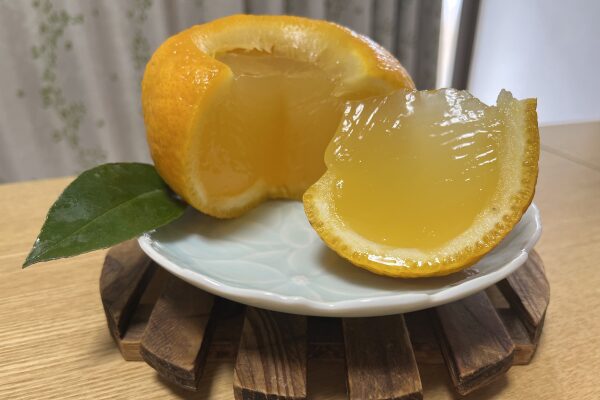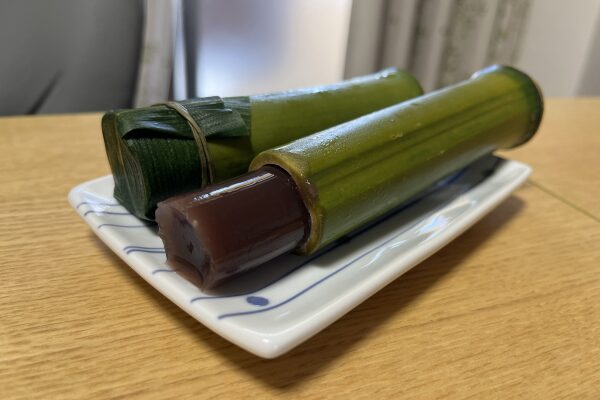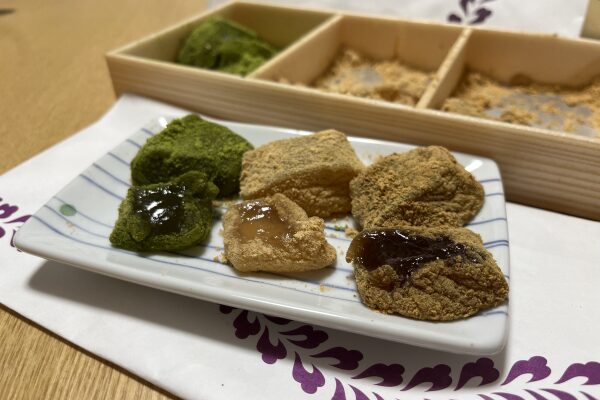Summer Wagashi of Kyoto : Traditional Japanese Sweets
Kyoto, known for its exquisite wagashi (traditional Japanese confectioneries), offers a variety of seasonal sweets. Despite the high humidity in the summer, there are several refreshing sweets that you should try. From the tangy to sweet, to the refreshing jelly desserts that melt in your mouth, Kyoto’s summer sweets will delight your taste buds and leave you craving for more.
Kyoto’s Summer Wagashi
Natsukanto
Natsukanto is a special wagashi. You can only get it from one Japanese confectionery store, Oimatsu. To make this, the flesh of a summer orange, nowadays quite rare in Japan, is hollowed out. The juice is strained, mixed with agar, and poured back into the orange.

It is worth noting that since this jelly is made from agar and not gelatin, it’s vegan.

The very flavor of summer oranges will make you feel refreshed, especially after cooling the orange. As it is big, you may want to cut several pieces and share them with a friend.
It is available from April but since it is very popular with Kyoto locals and frequent visitors alike, it typically sells out around early July. After it is sold out, they have a grapefruit version of natsukanto, called bankanto.
Wakaayu (Ayuyaki)
Wakaayu is a popular sweet treat in Kyoto, but it is also loved in other prefectures like Gifu. It is a crepe wrapped around a mochi filling and shaped like a fish. Many confectionery stores in Kyoto have their own original version of wakaayu.

The reason for its fish-like appearance is that it represents a sweetfish, known as ayu, that once swan plentifully in the Katsuragawa or Kamogawa rivers of Kyoto. Ayu fishing season typically starts in early summer and ends in October, which is why sweetfish are commonly enjoyed during the summer months. The soft cake dough and sticky mochi filling create a perfect combination, making wakaayu very refreshing. It goes especially well with a nice cold tea.
Kogei Gashi (Kyo Yokan)
Yokan is a highly popular wagashi in Kyoto. However, some of them are extremely detailed and beautiful. They may showcase seasonal scenery, like goldfish swimming in a pond or a beautiful starry night sky. There seems to be no common name for this type of sweet. People sometimes refer to it as kogei gashi or kyo yokan.

It’s so stunning that you might find yourself just wanting to stare at it instead of devouring it. Once you gather the courage to cut into it, you’ll find that the flavor is very simple and has a modest sweetness.
Mizu yokan in Bamboo
Mizu-yokan in bamboo, or sometimes called chikusui yokan, is very unique type of yokan enjoyed in summertime in Kyoto. By putting the yokan in bamboo stalks, the yokan absorbs a slight flavor of bamboo.
It is supposed to be eaten cold, and the smooth, cold texture of yokan is very summery. Unfortunately, not many stores sell this yokan.

Some stores use plastic bamboo, but all traditional confectionery stores use actual bamboo. You are supposed to take off the cover and puncture the bottom of the bamboo with a needle, to release the yokan from its mold. (the needle typically comes with the package)

Minazuki
Around the early summer, almost all Kyoto confectionery stores have minazuki. This triangular-shaped treat consists of a layer of uiro (a type of mochi) and a layer of sweet red beans. Minazuki is probably the most popular summer sweet in Kyoto and has very ancient roots.

On June 30th, many shrines in the Kansai region take part in the Nagoshi no Harae Festival to pray for peace during the summertime and to purify oneself from any events from the first half of the year. During this ceremony, nobels were given triangular pieces of ice, whereas commoners who would never be able to afford a luxury like ice, began eating minazuki to ward off misfortune.
Warabi Mochi
Warabi mochi is a type of wagashi commonly eaten throughout the year, but especially during summer. The word “warabi” means eagle fern, and warabi mochi is made from the powder that comes from the root of the eagle fern plant. Nara was known for its warabi, so many stores throughout Nara offered warabi mochi. Some of these stores even brought the delicacy to Kyoto, as the two regions are quite close to each other.

Warabi mochi is soft and smooth and comes in a variety of flavors, such as kinako and matcha. When you try it, you’ll understand why it’s so popular in the summer. It’s often served cold, which provides a refreshing and cooling sensation.


Leave a Reply